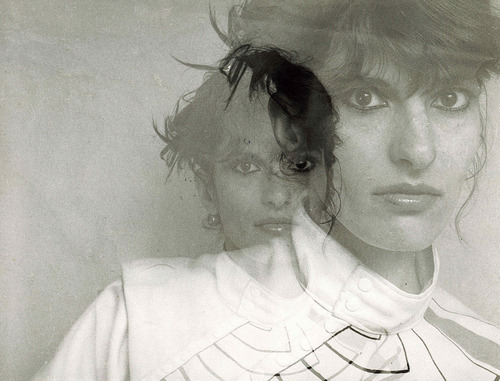
Francuska pjevačica koja je također komičarka, autorica dramskih i novinskih tekstova a nadasve - hoda po žici.
Pjesme joj također hodaju po žici, kao da bi se svaki čas mogle strmoglaviti u zijevajuću gravitaciju.
en.wikipedia.org/wiki/Hermine_Demoriane
vimeo.com/39829
HERMINE: THE WORLD ON HER PLATES
Femme fantastique, Hermine Demoriane has a world of demiurgic lives on her plate. Intellectually and artistically keen, Hermine has led the life of a chanteuse, playwright, journalist, and comedienne, all while taking a walk on the wildside of a tightrope. Knowing none other than to remain au courant, Hermine leads with a kind of grace that has made her a woman of all-time, a pillar of rarefied beauty—a lady limitless in her leaps. Today, she oversees Château de Sacy—her love affair with art, thankfully, never-ending.

Hermine Demoriane as a young girl. A peek into your family history.
Both my grandparents were distinguished citizens, one an architect who amongst other things succeeded Garnier at the Paris Opera. I’ve still got the clock with the bust of Homer mounted on yellow marble which was once in his office. A small ivory keyring is marked “Opera.” My other grandfather was an MP for several mandates at the time France was occupied. Thank God he didn’t go to Vichy. He was a “radical-socialist” and I insist he wasn’t a freemason. I presently live in France in his house in the village where he was mayor for 50 years. My parents, being the children of such worthies, met at a dance at the Elysée Palace. I am the eldest of four children. My siblings do not feature much in my life. Suspicion is paramount in our rapport. I’m married since 1965 to Hugo Williams, who writes poetry and has a column in The Times Literary Supplement. He is also The Spectator’s poetry editor. Our only child is Murphy, a journalist who is mother to Silver, age 9 and Jesse, age 6. Hugo believes that the best thing you can do in life is to write, therefore he’s delighted that grand-daughter Silver writes good poems. I’m delighted that she is very good at improvising songs, and have had her do so onstage with me to everyone’s delight.
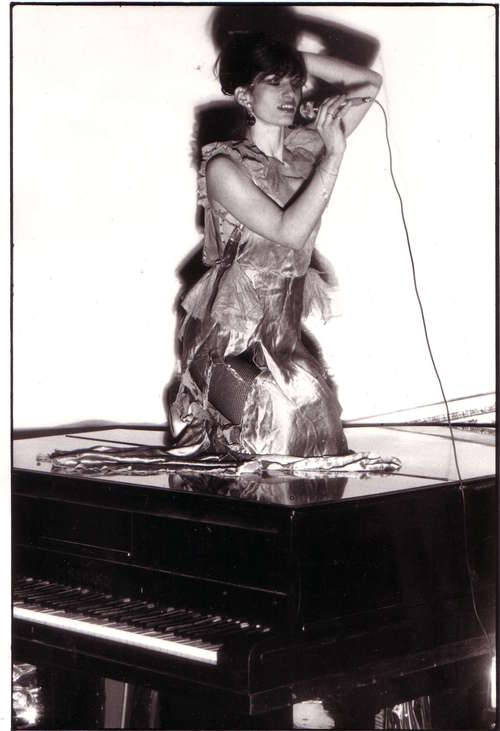
Any giddy stories of adolescence?
I am 14. I get up at seven and go to Mass. My mother goes to the Cannes Film Festival as a reporter for L’Alsace. I am not yet pubère. I’m late. I shall be a virgin for another seven years.
In the middle of the night, I am woken up by a friend. She wants me to go down to the garden with her to light fireworks. She says a couple of boys I know are there. I don’t move. I’m a coward. Soon I hear fireworks outside. The convent vibrates with the noise but no one stirs. I lie in bed, listening to the racket and thinking about the party I went to last week. I took a couple of the boarders with me but they couldn’t jive. Soon I hear nuns’ voices and footsteps approaching at full throttle. I drift back to sleep.
In the morning I am summoned to Mother Superior and accused of starting the whole thing because the boys they caught knew only my name. She reminds me that I am here in the Couvent de l’ Assomption as a punishment for too much party-going and fun. She will recommend that I be made to stay on as a boarder after my mother gets back from Cannes.
My mother arrives back from the festival in clouds of glory and decides to make an international incident out of the affair. She invites the fireworks boys over and talks to them before I am allowed to see them. I hardly know them. Later, she boasts to her friends and acquaintances on L’ Alsace that her daughter is the tremendously wicked brain behind the convent scandal. According to her, I am a naughty messed-up girl, completely out of control and wasting my life. To hear her, you would think I had personally corrupted the naïve, homely daughters of high-ranking military folk stationed in the nearby Black Forest. I have introduced them to inn-keepers’ sons, one of them from the notorious, but in fact ordinary, ‘Rhin et Danube’ bar.
At the weekend I go to several parties and hear a rumour going around that some boys broke into the convent and raped a nun or a pupil. A couple of girls have been sent home. I can almost jive.
The summer is upon us, but we aren’t allowed to go barefoot. We have to wear stockings. We draw seams on each other’s legs to fool the nuns, as the women did in the war out of penury. The nuns aren’t fooled for very long and soon they check on us by feeling our legs with their hands.
‘Les Anglais ont débarque!’ During these hot summer months my periods suddenly start. Like the English in the war, they have been long coming. I can remember the exact location of the lavatory at l’ Assomption—three steps up from the main hall—where I noticed it for the first time. My mother had told me it was bound to happen, but she hadn’t said why. At thirteen, I didn’t even know what the word ‘pregnant’ meant. I wasn’t bothered. I remember we went to a Sacha Guitry film in which Louis XIV walks up to the Grand Escalier at Versailles and pauses every other step to ask different mistresses whether they are pregnant or not. I asked my mother what it meant, being ‘pregnant.’ People around started giggling, especially the friends we’d come with. My mother thought I was making a fool of her, but I was sincere. I think I had come across the word before, but it had remained abstract so I had forgotten its meaning.
That, an excerpt from my book The Tightrope-Walker, Secker & Warburg 1989, and amongst Barry Mile’s top ten counterculture books of the Seventies favourite.
What were some memorable moments while with International Times?
I enjoyed interviewing Jean-Luc Godard, talking to him at the end of a press conference with my own questions about drugs. This was later taken up by the San Francisco Chronicle, who reproduced it on its back page. This wasn’t the case with each interview, but to enter the Arts Lab in Drury lane, London, and open the new issue with my latest piece inside, was great fun.
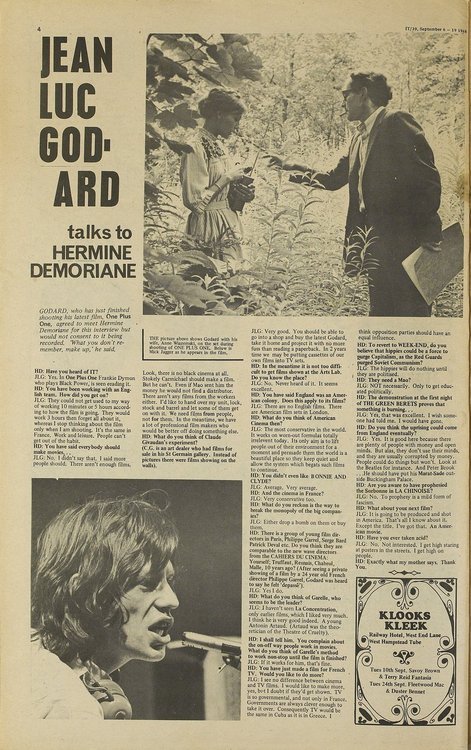
How did you come to meet Derek Jarman? Jubilee. Tell us about your experience as ‘Chaos.’
Two years after the Alternative Miss World, Derek Jarman engaged me to be one of the punk women in his film Jubilee. I was wearing black leather at the time so perhaps he thought he would save on costumes…I was taken aback when, at the end of the first day of shooting, Lucianna Martinez told me I couldn’t go home in my leather jacket; I had to leave it in the film wardrobe. What was I going to wear for the next five weeks? Derek solved it by paying for another jacket.
He wanted me to wear what I wore daily except for the shoes. Instead of my Frederick Freed white leather boots he wanted me to wear gym shoes or Wellingtons. I refused and consequently there is no shot of my feet in Jubilee.
I was to be ‘Chaos,’ a mute bike girl. So each morning I would arrive on set riding Hugo’s bike with an L-plate. One Sunday when I thought I could sleep in, I got a call from the producer asking me to be at Westminster Cathedral instantly for a bike scene. So I got on the bike. I was trying to remove a speck of dust from my left eye when I fell off at a turn. My hip bone got hurt and the gear-box never recovered. The bike scene didn’t take place.
It wasn’t in the script that I should walk the tightrope. Derek must have remembered the Alternative Miss World when he asked me to do it for my last scene in the film. Up till then I hadn’t done anything but look stoned. I hadn’t even filmed riding the bike.
The long rope and the winch had been stolen while I was in France, so it was the small rope that I set up on top of a recently burnt-down warehouse. Like the Alternative Miss World contest the film was taking place at Butler’s Wharf where Derek also had a studio.
I attached the rope to wooden pillars reduced to charcoal. As I walked, I could hear the rope criss-crossing through the charcoal. Half-way through I took off my skirt—a tight skirt with a zip right down the hem—and went on walking. Derek cut the scene so it ends with the skirt at my feet, which I didn’t like because it missed out the difficult bit, which was to free my feet from the fallen skirt on the rope, and because it was a misogynistic, not to say sexist, edit…
Eno was doing the music for the film, and I had to record Edith Piaf’s ‘Je ne regrette rien,’ which one hears as I walk the rope. Derek Jarman had at last put some words in my mouth.
….Vivienne Westwood made me a t-shirt with the word “Chaos” in large letters on the front.
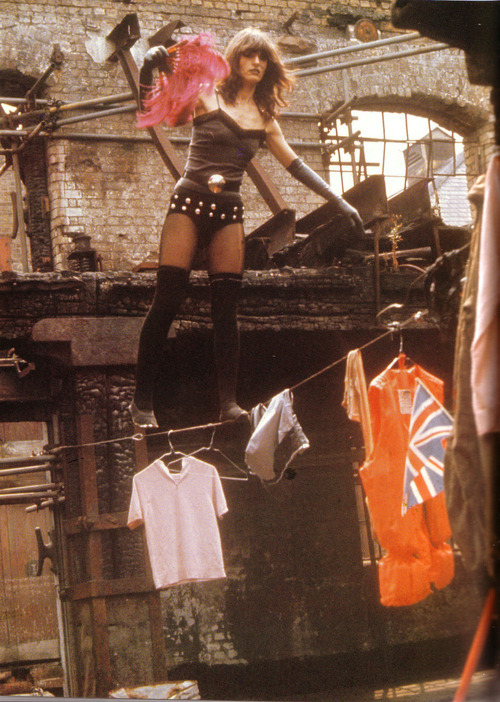
What brought about your love affair with the tightrope? When is the last time you walked?
This is described on the first page of my book. I could not better it:
On Wednesday, 28 April 1971 I took my first steps on the tightrope. The Canadian sculptor Robert Morris had transformed part of the Tate Gallery into a sports centre, with ropes to climb and weights to lift. He had also rigged a length of wire, three feet from the ground, between two marble columns. There was even a range of gym shoes for visitors willing to have a go.
The tightrope was what attracted me. The first time I tried I stood on it for a mere two seconds before falling off. I tried again, taking my turn in the queue after each attempt. Without help, let alone tuition, you had to find out for yourself how to put off the moment of falling. Five steps was the best I could manage that first day.
I went back on the Friday and, to my total surprise, walked the length of the wire. Alas, the exhibition closed down: someone had broken his leg using one of the items exhibited. It seemed I was never to tightrope-walk again.
The day after this brutal closure I felt painfully frustrated. I had been there, I had had my chance and succeeded, yet before I had time to improve the rope wasn’t available to me any more. Or was it? What had they done with it? I decided to ask my faithful Super Secretary to find out what had happened to that wire. It turned out that it had been especially made for the Tate Gallery. I had to promise Super Secretary Scottie the earth for him to call the Tate again and manifest my will. He was kept waiting twenty-four hours for an answer, during which I dreaded to experiment before getting the right rope. I knew Scottie would say an orange nautical rope would do—he’s always getting back to these nautical ropes for some reason—but he didn’t, he just said Robert Morris’ tightrope was being saved for us. I was walking on air.
That was on Sunday, the 6th of May. Scottie brought it at once to Islington and fixed it to my garden, one end to a brick wall, the other to the lavatory pipe. (No marble columns in my abode!) As a child, Blondin made his first tightrope from a skipping rope tied to a couple of chairs. This was hardly better. With the garden wall bulging alarmingly whenever tension was applied, it wasn’t a very convincing installation, and I didn’t even try to walk on it. Anyway, it had started to rain and I didn’t want the wire to get rusty. We took it down and put it away. By now, my secretary was having some dark thoughts; I didn’t deserve the tightrope and he was going to take the rope away till I went to bed with him. I hit him on the nose and he hit me on the lips. Then I said something magical and we made peace and went to three builders’ merchants to find a bolt that would fix the rope to the wall. We couldn’t find any, so I went home to look in the Yellow Pages for the right sort of builders’ merchant.
I may not walk the tightrope any more, yet I have been taking champagne to Kensal Green Cemetery, London, in the peak of February, in order to toast to Blondin the French man who walked across Niagara Falls in 1859, was born on the 29th and died on the 23rd, and happened to be buried in London. I’ve done this for over twenty years.
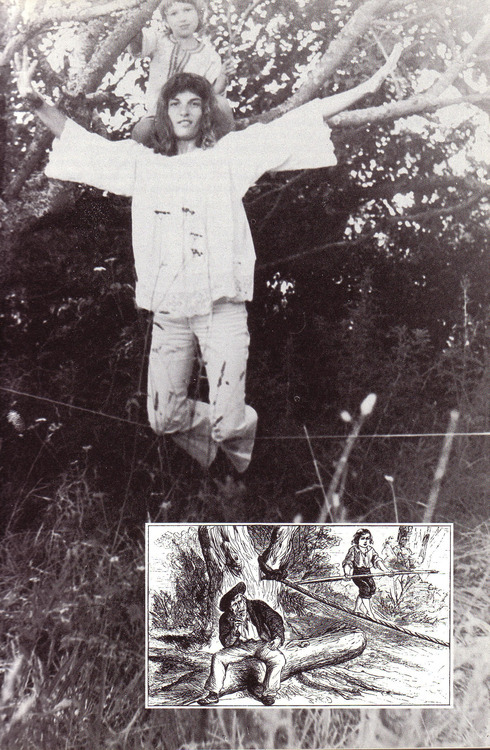
The World on my Plates—love on vinyl. I am particularly fond of Happy Holidays. Who was your muse?
This was written by Ian Kane and was used by French film-maker Marcia Romano throughout her Quand j’étais gothique 2011. I’ve done a number of songs by Ian Kane, I seem to empathize with his lyrics—and his tunes of course. So much so that Ian and I revived Salomé Discs so that a number of his songs once recorded at Basel could be released after the two LTM cds.
Tell me you still have that hot polka dot number from the album The World on my Plates.
Yes. I keep stuff. I wore last week at the ICA, a pink lamé dress I hadn’t worn for 30 years. Bibiche, the dress-maker, was on my guest list.

COUM Transmissions, describe your involvement. Are you still in touch with any current or former TG members?
My involvement was in 1972, Hull. Genesis P. Orridge of Coum used to read me IT and later I’d become a Swiz superstar in The Longest Most Meaningless Movie in the World. I saw them briefly when they arrived in London but I haven’t kept in touch.
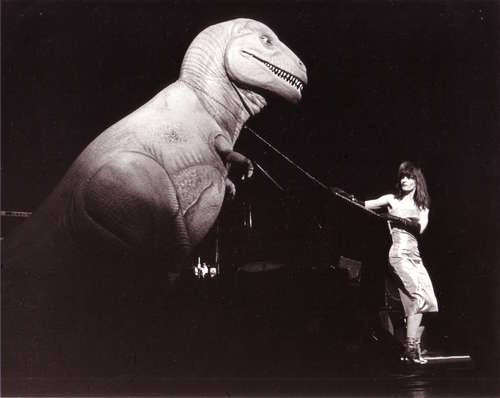
Tell us about Salome— are you more inspired by her story or her work? Is the label still active?
Salomé Discs was started when Virgin, having printed 20.000 colour sleeves for my first single “Torture” in 1980, cancelled. I borrowed money to press 2.000 and stamped Salomé Discs on top of the Virgin logo. More recently, LTM, who had made two cds out of my singles and albums, turned down a third cd when I couldn’t locate the master in Switzerland after some twenty years. It was eventually sent via email which LTM didn’t like. On top of this, time had elapsed since the former cds’ release and I couldn’t get my act together with Myspace. Volunteer gardeners at Sacy put in the wrong name then couldn’t undo it. So LTM dropped it. That is how Salomé Discs came to be revived. The cd includes tracks I really like, mostly by Ian Kane but with a few Cajan ones as a hommage to Cleoma B. Falcon, whose fan club I started and under whose name I went touring with accordion and fiddle in Switzerland and Germany in the late 80’s. The cd is called Who’ll come walking? and may be downloaded too.
My tightrope act was inspired by the dance of the Seven Veils, veils I would shed as I walked on the tightrope. I would peel off my costume to reveal a flesh-painted bikini. It was Robin Klassnik, who now runs Matt’s Gallery, who had painted it, pubic hair included.
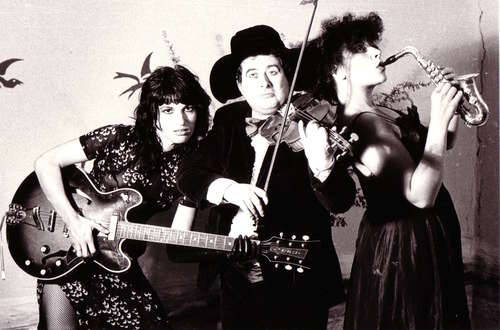
Give us a brief account of Soirée Existentialiste.
It was a matter of putting together an evening of musicians / performers whom I liked and who didn’t usually appear together, to celebrate Jean-Paul Sartre, who had just died. There was a lot of fly-posting for it, I would set out at all hours on my bike with a bucket of glue and a large brush with this really nice poster created by Rick Rayner-Canham, who’d also done the flattering photo. I was wearing a Modern Classic dress with a Mondrian design. Dress completely gone, stolen when I lent it to a Jubilee star who was going to Cannes to present the film.
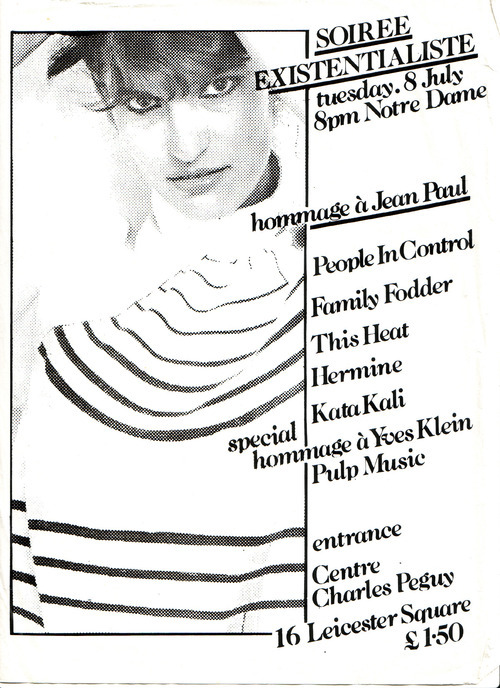
Château de Sacy. Was the artists’ residency your conception and can you tell us a little more about this?
It was artist David Medalla’s idea to make use of my grandparents house in Picardy, which I wished to hold on to because it had so many happy childhood memories. Exhibitions, and later residencies, started in 1996. Last year we had a retrospective at Europe House, London, called “Made-in-Sacy,” which was a great success but a commercial failure.
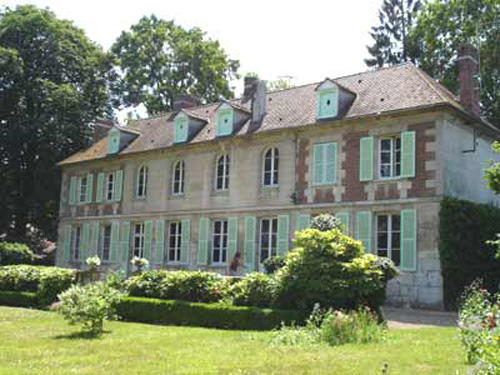
Do you remember your dreams when you wake from sleep? What was the last that you can recall?
I rarely do and right now, I haven’t got any dreams available.
Your current obsession.
My husband to be given a kidney and to not spend so much time in the hospital.
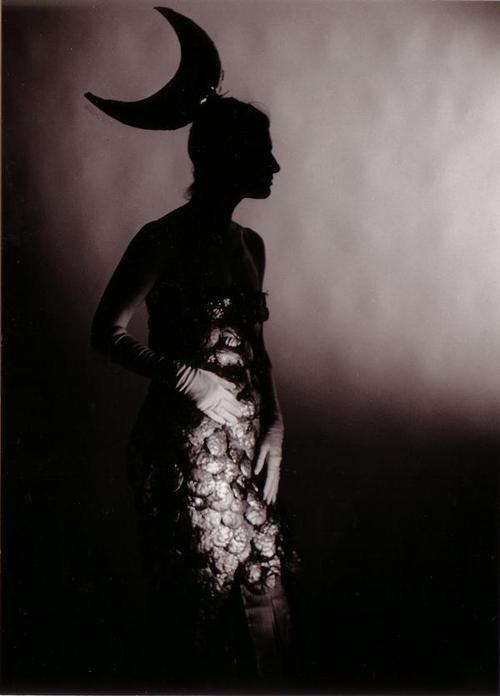
MORE HERMINE DEMORIANE


"The MOR 'chick singer' shifted dramatically out of focus" is about as good a précis of the music career of the new wave diva Hermine Demoriane as is possible in one short soundbite. An unclassifiable performer, whose career spans writing, acting, comedy and tightrope walking as well as singing, Hermine's musical reputation rests on her cult mini-album from 1982, The World On My Plates, on which the allure of her vaudeville torch songs is much enhanced by its iconic cover image of the artist loading singles into a dishwasher, poised and chic in a designer polka-dot dress.
Born in Neuilly (Paris) in 1942, Hermine Demoriane is the daughter of an engineer father and a journalist mother. At the end of 1964, Hermine visited London and immediately met the poet Hugo Williams, whom she married the following year. The couple have a daughter, Murphy. Lifestar, published in 1969, is a journal of her pregnancy. Hermine also contributed to publications such as International Times and The London Magazine. A visit to an exhibition by the artist Robert Morris at the Tate Gallery in April 1971 inspired Hermine to take up tightrope walking, which would become her obsession for the next five years. Her various works during this period, until March 1975, are fully documented in her book The Tightrope Walker.
As a tightrope walker (or funambulist), Hermine found a measure of fame by attempting to gain permission to cross the Serpentine in Hyde Park in 1973, performing with Coum (later to become Throbbing Gristle), Welfare State and The Moodies, and also completing a season with the Grand Magic Circus in Paris in 1974. However, the lasting image of Hermine the ropewalker is her appearance in Derek Jarman's celebrated quasi-punk film Jubilee, shot in 1977, in which she was cast as Chaos, a mute biker girl, and also sang a version of the Edith Piaf classic Je ne regrette rien. While never a dedicated punk rocker, Hermine had previously performed at Andrew Logan's ultra-camp Alternative Miss World contests, and appears in the 1978 film of the same name. In spring 1976 she performed two gigs as a vocalist with The Subterraneans, a short-lived outfit featuring NME scribe Nick Kent and members of The Damned, which in turn lead to Hermine recording a debut single (Chinese Shadows) with Kent and Peter Perrett of The Only Ones, although these recordings remain unreleased.
Having abandoned the tightrope even before the Jubilee shoot, Hermine returned to writing, producing three plays in 1978, 1979 and 1980, Lou Andréas Salomé, He Who Is Your Lord Is Your Child Too and The Knives Beside the Plates. The first play was seen by David Cunningham, the art-pop musician and producer behind The Flying Lizards, who had scored a surprise top ten hit with a postmodern cover of Money through Virgin. Seizing the opportunity to record another deadpan female vocalist, this time with a strong Continental accent, Cunningham contacted Hermine and invited her to record her skewed version of Torture, the John D. Loudermilk lament famously recorded by the Everly Brothers in 1964.
Of her distinctive accent, Hermine revealed: "I can't stop it. People often think it's a send-up, like an affectation, but it is for real. It's terribly bad, because I can't complain when I go to the shops, people just laugh… I'm really not interested in singing as such. For me it's a lot to do with delivery, and interpretation. I know it's pretty erratic. Either you go for it or you can't stand it. It must annoy a number of people that someone like me could get away with so much. I just try things out. I don't call myself an artist or a singer or anything like that. I find myself being called a performance artist, but it certainly wasn't anything of my doing." (Square Peg 1985)
Although the A-side was a cover version, the flipside Veiled Women was a Nico-esque original, and featuring former Moodies colleague Rod Melvin on piano and organ. As on Cunningham's art-pop productions as The Flying Lizards, Hermine didn't so much sing as intone the lyrics, over backing music featuring dustbin percussion, cartoon piano and some outré sax noise. As VS 347, the 7" single was due for release on Virgin in June in tandem with The Laughing Policeman, but after Cunningham took that single to Arista instead, Hermine found her own release shelved. However, the powers-that-be at Vernon Yard agreed to sell her 21,000 finished colour sleeves and the metal stampers for the princely sum of £59. The result was an independent pressing of 2,000 copies on her own Salomé Disc imprint, released in August and distributed by Rough Trade and Fresh.
As Hermine explained to Adrian Thrills of the NME: "The record is now in my own hands and not just the product of a big record company. I'm happy to be in full control. No whim of some young executive is going to shake me this time. I very much doubt if I'll get to use the 19,000 sleeves left over, but at least it's out." Both singer and story made good copy, and print reviews were positive, praising an "intoxicating, mysterious record" (Zigzag) as "fabulous" (New Music News), "somewhat reminiscent of Françoise Hardy" (Music Week) and "brilliant - a mutation even worse (and therefore better) than the Nashville Teens could ever have conceived of" (Sounds).
After the death of the French intellectual Jean-Paul Sartre in July 1980, Hermine organised a "soirée existentialiste" at the Notre Dame Hall on Leicester Square. The bill also featured This Heat, Family Fodder, People in Control and Furious Pig, as well as dancers and "pulp music" by Paul Burwell and Anne Bean. According to Melody Maker, "A strange evening of entertainment it turned out to be, wavering between incongruity, pretentiousness and a couple of welcome surprises. Hermine herself alternated between changing clothes, washing glasses behind the bar and occasionally coming on and singing little numbers in the style of a bar-room Marlene Dietrich."
After the Salomé Disc edition of Torture sold out, Hermine licensed both tracks to Human Records, who then requested two further tracks to expand the single into an EP. Foxes Will was a mini-epic featuring cello by Graham Painting and bassoon by arranger Felix Fiedorowicz, while Born a Woman treated the old Nashville standard to a deliberately crass boogie treatment, courtesy of producer/arranger Alig, of Family Fodder. Charles Bullen of This Heat also co-produced the latter track. Much delayed, the four-song EP finally appeared in March 1981.
In October 1980 Hermine began performing musical breaks at The Comic Strip, the pioneering alternative comedy club then resident at the Boulevard Theatre (Raymond Revuebar) in Soho. The connection came about after Hermine was introduced to Strip writer/director Peter Richardson by members of the band Furious Pig, and would in turn bring her into contact with comedians such as Rik Mayall and Ade Edmondson, Keith Allen, and later Dawn French and Jennifer Saunders. Her musical links included renditions of Torture, Blue Angel, Wives & Lovers and Valley of the Dolls, for which she often burst out of a paper cone made of copies of the Financial Times. Reviewing the opening night, The Stage described Hermine as "a beautiful girl who can't sing and is liable to break down into a fit of giggles, and is quite frankly hilarious".
Elsewhere, Edward L. Fox of the NME wrote that Hermine "sings quiet, funny songs to a tinkly piano. She soothes the minds of the drinking and lounging audience away from thoughts of the hail of unemployment statistics going on outside. Her songs are all about repression and physical pain. The voice is imperfect and fragile, with a strong accent. She begins her act on a high stool in the dark, a red bicycle lamp held in each hand below her face, and sings a 'torch' song called Blue Angel in the red light. She disappears, then re-enters the light to sing again in a hesitant, distant style, as if she was performing in public for the first time."
Hermine's sojourn at The Comic Strip ended in February 1981: "It's good fun some nights. It depends how pleased I feel with myself. I appear for ten minutes doing two or three songs at a time. As for the show itself, I'm getting tired of it, because I know all the jokes. There are people there who haven't changed one syllable in their acts since October. Then there are the drunks who laugh for the wrong reason. I can't stand that drunken laugh."
After Richard Strange's celebrated Cabaret Futura closed down in May 1981, Hermine took over Monday nights at the Latin Quarter in Wardour Street together with Anne Bean. These events included performance artists, odd groups, audience participation and a Desert Island Disc-style spot, in which interesting guests introduced interesting records. Sadly the new event night lasted just two weeks before the club was closed down and boarded up (with their piano still inside), after which the extravaganza moved to the Screen on the Green in Islington.
Hermine's second single was recorded in 1981 and coupled a version of Dory Previn's Valley of the Dolls with a gorgeous original song, TV Lovers. The sound was gentler than before, dominated by piano and cello, with TV Lovers (written by Ian Kane) described by Hermine as "a song with a lot of cliché words". Relations with the Human label were already strained by the time it appeared in July 1981, and reviews were mixed, ranging from "sensitive, creative, contemporary quality pop at its best" (Music Week), "unutterably sophisticated" (Hot Press) and "atmospheric and intoxicating" (Zigzag) to merely "nice to have around" (Sounds). According to the NME, "Hermine could be Françoise Pascal in the process of slowly but surely swallowing the medicine chest", while Record Mirror judged the single "encore une flop".
In December 1981 Hermine performed at the opening of the multimedia exhibition Art and Artifice at B2 in London, which also featured work by Derek Jarman and Andrew Logan. Her surreal performance at this event co-starred a ten-foot high 'pet' Tyrannosaurus Rex, designed and operated by Jules Baker, who returned for Hermine's show at The Fridge in Brixton in March 1982. Always eclectic, Hermine also organized Café des Alliés, a series of eight shows at the Centre Charles Péguy on Leicester Square at the end of March 1982, combining performance art, poetry and music from a diverse cast of 40, including Ian Hinchliffe, Keith Allen, Steve Cripps, Carlyle Reedy, Deborah Evans (The Flying Lizards), Anne Bean and David Medalla, exploring themes related to the First World War and the overall experience of being foreign. At about the same time Hermine took a role in John Maybury's film The Court of Miracles.
Although Hermine's striking image and performances generated any amount of reviews and column inches, capturing the wit of her live act(s) in a recording studio proved more difficult, and no British labels showed any interest after the Human deal ended. Happily, the cosmopolitan Brussels-based indie Crammed Discs stepped up to the plate, and agreed to release a six-track mini-album, comprising minimalistic versions of Blue Angel (Roy Orbison), Too Many Men In My Life (Ruth Wallis), The Thrill Is Gone (Henderson & Brown) and I Won't Make It Without You (Nick Lowe), together with two originals by Ian Kane, Happy Holidays and Waiting. Most of the material was newly recorded at Elephant Studio, although Blue Angel was an older recording salvaged from cassette. Despite Hermine's limitations as a vocalist, The World On My Plates is an attractive and charming record, and the one on which her cult reputation as a "new wave diva" is based. The iconic sleeve image by Richard Rayner-Canham, of Hermine loading singles into a dishwasher, unarguably adds to the allure, and later became a popular postcard sold through the ICA.
Of her chosen cover versions, Hermine revealed: "I don't like songs that are too schmaltzy. It's very difficult with what I do not to fall into the schmaltz thing. I'm very wary of kitsch. I think you have to be very careful to put on a good show, which is demanding of people and at the same time one which they can enjoy."
Released by Crammed in April 1982, The World On My Plates was supported by a handful of live dates around Europe, including Paris (with Allez Allez), Brussels (with Marine) and Gent (with Minimal Compact). Undoubtedly the strangest was a support slot with metal merchants Girlschool at the London Hammersmith Odeon on 13 May, at which Hermine was joined by Jules Baker's giant pet dinosaur. The album sold well, reaching no 13 in the Rough Trade indie chart on the back of enthusiastic reviews, and also gained a release in Japan. The critics were now universally appreciative:
"Another music from a different kitsching. Musical backings are kept to a minimum: mistily tinkled piano keys, occasional snaking columns of cello and a bit of fake jazzy sax. Hermine is French and continues to exercise her almost petulant, devil-may-care abuse of bland English vowel sounds. It is this foreign larynx wrapping itself around, and warbling through, these songs that gives rise to the common torch singer description of 'Ridiculous!' Her quietly dazzling ability is to tread excruciatingly close to cabaret novelty yet shed light on the contradictions and dogma lurking within these songs. This vinyl succeeds in capturing the humorous but strangely unsettling talent that she displays live where the singles failed, and six songs allow time to savour and soak in the Hermine experience." (Mick Sinclair, Sounds)
"Show me the way to the next café bar. Hermine lives in a demi-monde, a world of sleaze and cramped vamps. The torch sets this shadowland alight, though with a flame that puts Carmel, Ronni et al to the stake. All six tracks are wonders, and the voice coats every word in fondly rolled broken English. Old standards like Too Many Men in My Life are knocked out with a smattering of lines like 'eet ze sac' that brings the French farce of the singer into line with the ribald American humour of the lyricist. This one deserves to go gold." (David Dorrell, NME)
Unsurprisingly, given the spurious "torch singer" tag, Hermine found herself bundled up with the spurious "new jazz" trend, and appeared at The Joy of Mooching, a season held at the London ICA in August 1982, alongside Allez Allez, Swamp Children, the French Impressionists, Biting Tongues, Weekend, Animal Nightlife and Animal Magic. The ICA performance proved typically theatrical and tongue-in-cheek: "Not so absently toying with an Eiffel Tower model - some fragments of some songs - some slapstick Nico - clown-y brandishing of scissors after severing the bass player's pigtail. To say that she doesn't sing very well is les appropriate than to say that she makes the most of what she does. She would never get away with it in a lot of places, but she does here. Her group of alto and soprano saxophones, and bass or piano support attentively" (Mark Cordery, NME)
In November 1982 Hermine embarked on another string of Crammed-sponsored live shows around Europe, including dates at North London Polytechnic and The Hacienda in Manchester, both with the Honeymoon Killers, followed by several headlining dates in Germany, and a short French tour with Minimal Compact and the Honeymoon Killers in December, and a Crammed event at the Transmusicals festival in Rennes. By now her highly entertaining live set included covers of Cry Me A River, La Valse de 99 Ans and Is That All There Is?, the latter adapted as a hilarious extended monologue on the vagaries of the independent music scene. However, touring was not to Hermine's taste, as she subsequently revealed to Square Peg magazine: "I found myself turning into a kind of send-up of a singer. There was a double bass and a saxophone, and it was like a group and I was really becoming stale and ridiculous. Especially on tour I couldn't stand being with the musicians. I get bored when things start to go smoothly."
The next Hermine record would not emerge until the following year. Plans to release her debut album proper through Crammed fell through, which meant protracted delays while a new deal was pursued. In December 1983 Hermine travelled to New York, performing at Danceteria, Pyramid and the Limbo Lounge, then returned to London via Paris. Despite offering the album to 40 different labels, however, Lonely At The Top was eventually released through a revived Salomé Disc in July 1984. Produced by Dominic Weeks and Cass Davies (of Furious Pig), the ten-song album was a trademark mix of skewed covers and Weeks/Davies/Demoriane originals, the former including Death of Samantha, Yoko Ono's ode to a stillborn child, the traditional Mauritian song Noir Noir Noir and the Neil Sedaka standard Un aut' soir d'ennui. Again reviews were positive:
"Lonely At The Top is an idiosyncratic mixture of cod-Brechtian dramatics, folk song and self-consciously arty rock, wrought from a small, exotic orchestra, including bassoon, cello, accordion and glockenspiel, and delivered in a heavily mannered accent. The French no doubt have a word for 'mixed bag' and Hermine Demoriane would know it well." (The Guardian)
"A clutch of material ranging from deranged covers of Yoko Ono and Neil Sedaka numbers to originals, it confirms Hermine as the Helen Shapiro/Dionne Warwick of the offbeat 80s - the MOR 'chick singer' shifted dramatically out of focus." (City Limits)
"The originals are somewhat difficult for me to describe, lying in form and style somewhat beyond that to which I am accustomed. Her voice, a mixture of Edith Piaf, Cindy Lauper and Ophelia in her last days, intones lyrics that range from the silly to the confused, while her entourage deliver a perfunctory imitation of Stravinsky's Rite of Spring. The result is not immediately appealing, except perhaps to the clinically minded. However, everything comes together on the cover versions. These seem to provide both a focus and a framework for the group's energies and the result is amazingly original, enthusiastic, intelligent and enjoyable." (Timothy C. Heck, Earwax (Canada))
Distributed by Rough Trade, Lonely At The Top sold out its pressing of 2,500 copies, but was destined to be the last Hermine record. Sessions for a second album, recorded in Switzerland, went unreleased, and live dates with Einsturzende Neubauten in Europe in June 1984 were something of a mismatch. Subsequent theatrical performance projects included Stanhope (1985), Fountain of Youth (1987, at ULU swimming pool), Masculinity (1988), L'éternelle monotonie de la passion (1988), Share-Out 89 (1989) and Moonlight and Roses. In 1989 Secker & Warburg published her book The Tightrope Walker, which combines her London diary between April 1971 and March 1975 with a pictorial history of funambulism through the ages.
Despite the absence of any new records since 1984, viewers of French & Saunders and Absolutely Fabulous on television and DVD will have heard Hermine Demoriane singing more recently. For it was she who provided the distinctive Continental femme fatale vocals on several pastiche numbers in both shows, including pin-sharp parodies of Françoise Hardy and Nico, to name but two. In the mid-1990s Hermine returned to France, having inherited her family home, which she has since developed into an arts centre. The records she made between 1980 and 1984 are but one chapter in her picaresque life story, but what a charmed - and charming - tale they tell.
James Nice


Nema komentara:
Objavi komentar